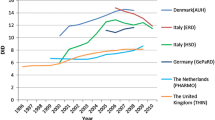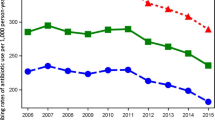Abstract
The purpose of this study was to investigate geographic variations in the use of quinolones in France and their associated factors. All reimbursement claims of antimicrobials were collected for 90 % of the French population for the year 2007. Dispensed quantities were then converted into defined daily doses (DDD) and adjusted for the age structure of the national population. Correlations between quinolone use and total antimicrobial use and some morbidity and socio-economic factors were studied using Spearman’s rank correlation coefficients. On average, 2.05 DDD of quinolones per 1,000 inhabitants per day (DID) were dispensed in 2007 in France, accounting for 10.2 % of the total antimicrobial consumption in adults. A 40 % variation was observed between the regions with the lowest (1.73 DID) and the highest use (2.44 DID). This variation was more important for anti-pneumococcal quinolones than for quinolones directed against urinary tract infections (coefficients of variation: 26 vs. 6 %). Quinolone use was correlated with some regional socio-economic factors (unemployment, growth domestic product, health expenditures) and physician density, but was independent of the total antimicrobial use. After adjustment for age, large variations in quantitative and qualitative quinolone use were observed across French regions, especially for anti-pneumococcal fluoroquinolones. These results, though not controlled for potential epidemics variations, argue in favour of a possible improvement in quinolone prescribing to be achieved in some regions.



Similar content being viewed by others
References
Sabuncu E, David J, Bernède-Bauduin C et al (2009) Significant reduction of antibiotic use in the community after a nationwide campaign in France, 2002–2007. PLoS Med 6:e1000084
Huttner B, Harbarth S (2009) “Antibiotics are not automatic anymore”—the French national campaign to cut antibiotic overuse. PLoS Med 6:e1000080
European Antimicrobial Resistance Surveillance System. Available online at: http://www.ecdc.europa.eu/en/activities/surveillance/EARS-Net/database/Pages/database.aspx. Last accessed 3 March 2012
Gallini A, Degris E, Desplas M et al (2010) Influence of fluoroquinolone consumption in inpatients and outpatients on ciprofloxacin-resistant Escherichia coli in a university hospital. J Antimicrob Chemother 65:2650–2657
Goldstein EJC, Garabedian-Ruffalo SM (2002) Widespread use of fluoroquinolones versus emerging resistance in pneumococci. Clin Infect Dis 35:1505–1511
Davidson R, Cavalcanti R, Brunton JL et al (2002) Resistance to levofloxacin and failure of treatment of pneumococcal pneumonia. N Engl J Med 346:747–750
Wenzel RP, Edmond MB (2000) Managing antibiotic resistance. N Engl J Med 343:1961–1963
van de Sande-Bruinsma N, Grundmann H, Verloo D et al (2008) Antimicrobial drug use and resistance in Europe. Emerg Infect Dis 14:1722–1730
Livermore D (2004) Can better prescribing turn the tide of resistance? Nat Rev Microbiol 2:73–78
Harbarth S, Samore MH (2005) Antimicrobial resistance determinants and future control. Emerg Infect Dis 11:794–801
Goossens H, Ferech M, Vander Stichele R et al (2005) Outpatient antibiotic use in Europe and association with resistance: a cross-national database study. Lancet 365:579–587
Powell AE, Davies HTO, Thomson RG (2003) Using routine comparative data to assess the quality of health care: understanding and avoiding common pitfalls. Qual Saf Health Care 12:122–128
Anis AH, Carruthers SG, Carter AO et al (1996) Variability in prescription drug utilization: issues for research. CMAJ 154:635–640
Parchman ML (1995) Small area variation analysis: a tool for primary care research. Fam Med 27:272–276
Paul-Shaheen P, Clark JD, Williams D (1987) Small area analysis: a review and analysis of the North American literature. J Health Polit Policy Law 12:741–809
World Health Organization Collaborating Centre for Drug Statistics Methodology. ATC/DDD Index 2012. Available online at: http://www.whocc.no/atc_ddd_index/. Last accessed 3 March 2012
Bases Eco-Santé. Available online at: http://www.ecosante.fr/. Last accessed 3 March 2012
Institut National de la Statistique et des Études Économiques. Available online at: http://www.insee.fr/en/default.asp. Last accessed 3 March 2012
Adriaenssens N, Coenen S, Versporten A et al (2011) European Surveillance of Antimicrobial Consumption (ESAC): outpatient quinolone use in Europe (1997–2009). J Antimicrob Chemother 66(Suppl 6):vi47–vi56
Adriaenssens N, Coenen S, Versporten A et al (2011) European Surveillance of Antimicrobial Consumption (ESAC): outpatient antibiotic use in Europe (1997–2009). J Antimicrob Chemother 66(Suppl 6):vi3–vi12
Goossens H, Ferech M, Coenen S et al (2007) Comparison of outpatient systemic antibacterial use in 2004 in the United States and 27 European countries. Clin Infect Dis 44:1091–1095
Metz-Gercek S, Maieron A, Strauss R et al (2009) Ten years of antibiotic consumption in ambulatory care: trends in prescribing practice and antibiotic resistance in Austria. BMC Infect Dis 9:61
Blix HS, Engeland A, Litleskare I et al (2007) Age- and gender-specific antibacterial prescribing in Norway. J Antimicrob Chemother 59:971–976
Linder JA, Huang ES, Steinman MA et al (2005) Fluoroquinolone prescribing in the United States: 1995 to 2002. Am J Med 118:259–268
Eurostat. Available online at: http://epp.eurostat.ec.europa.eu/portal/page/portal/statistics/themes. Last accessed 3 March 2012
Andriole VT (2005) The quinolones: past, present, and future. Clin Infect Dis 41(Suppl 2):S113–S119
Glass SK, Pearl DL, McEwen SA et al (2010) A province-level risk factor analysis of fluoroquinolone consumption patterns in Canada (2000–06). J Antimicrob Chemother 65:2019–2027
Filippini M, Masiero G, Moschetti K (2006) Socioeconomic determinants of regional differences in outpatient antibiotic consumption: evidence from Switzerland. Health Policy 78:77–92
Filippini M, Masiero G, Moschetti K (2009) Small area variations and welfare loss in the use of outpatient antibiotics. Health Econ Policy Law 4:55–77
Masiero G, Filippini M, Ferech M et al (2010) Socioeconomic determinants of outpatient antibiotic use in Europe. Int J Public Health 55:469–478
Lauer C (2003) Education and unemployment: a French–German comparison. SSRN eLibrary. Available online at: http://papers.ssrn.com/sol3/papers.cfm?abstract_id=439742. Last accessed 3 March 2012
Francesconi M, Orszag JM, Phelps ES et al (2000) Education and the natural rate of unemployment. Oxf Econ Pap 52:204–223
Russell H, O’Connell PJ (2001) Getting a job in Europe: the transition from unemployment to work among young people in nine European countries. Work Employ Soc 15:1–24
Acknowledgements
This work did not receive any specific funding.
Transparency declarations
The authors have no conflicts of interest regarding this study.
Author information
Authors and Affiliations
Corresponding author
Rights and permissions
About this article
Cite this article
Gallini, A., Taboulet, F. & Bourrel, R. Regional variations in quinolone use in France and associated factors. Eur J Clin Microbiol Infect Dis 31, 2911–2918 (2012). https://doi.org/10.1007/s10096-012-1640-8
Received:
Accepted:
Published:
Issue Date:
DOI: https://doi.org/10.1007/s10096-012-1640-8




